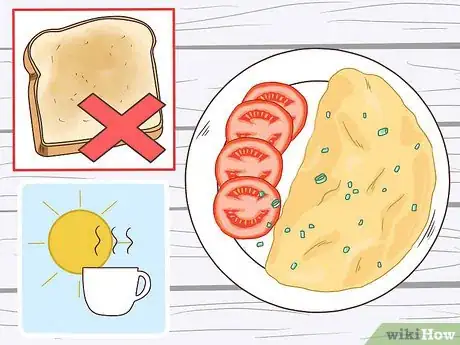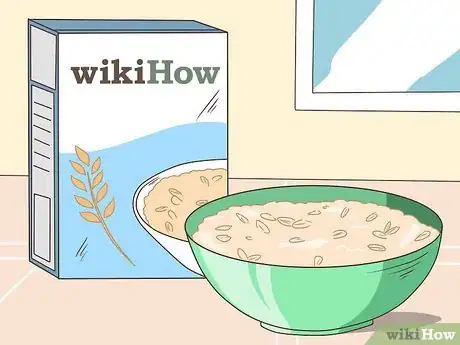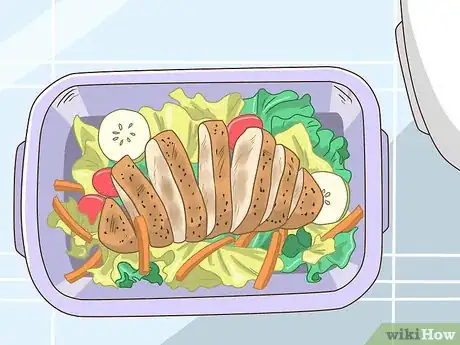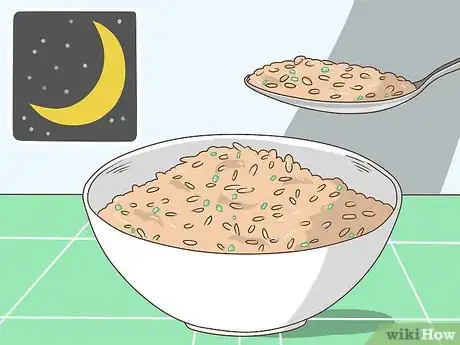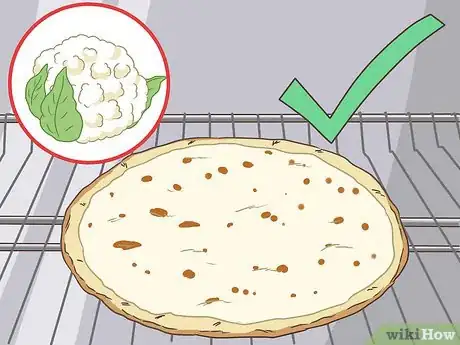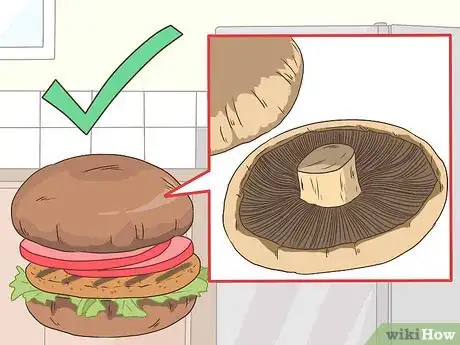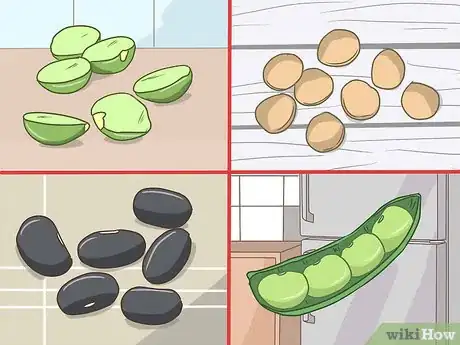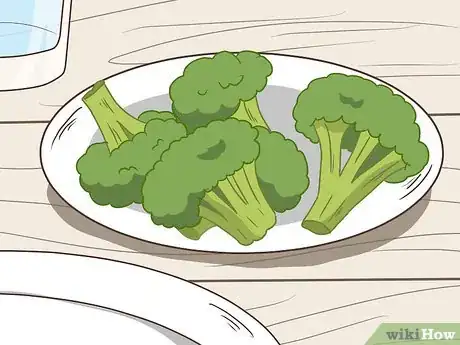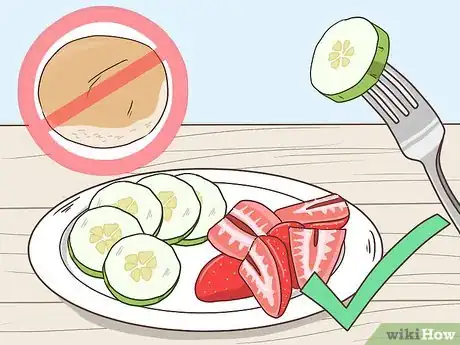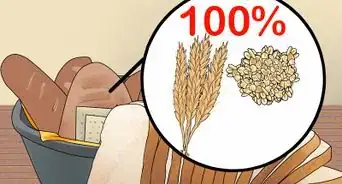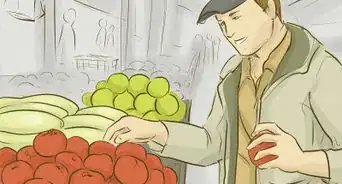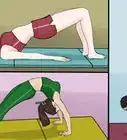This article was co-authored by Claudia Carberry, RD, MS. Claudia Carberry is a Registered Dietitian specializing in kidney transplants and counseling patients for weight loss at the University of Arkansas for Medical Sciences. She is a member of the Arkansas Academy of Nutrition and Dietetics. Claudia received her MS in Nutrition from the University of Tennessee Knoxville in 2010.
There are 9 references cited in this article, which can be found at the bottom of the page.
This article has been viewed 15,897 times.
Whether you are hoping to reduce your carbohydrate or sugar intake, fight inflammation,[1] or remove gluten from your diet for another reason, avoiding bread can help.[2] Further, packaged breads should be avoided, as they offer very little nutritional benefit and often contain artificial coloring, flavorings and preservatives. Familiarize yourself with ways to plan meals without bread, find bread equivalents, and make sure you're getting enough fiber while cutting bread from your diet.
Steps
Planning Meals Without Bread
-
1Pass on toast at breakfast. Toast and other bread type breakfast foods are common in many people’s diet, as they are quick and easy to prepare. There are many healthier breakfast options, however. In particular, opt for eggs with veggies and your favorite herbs.[3]
- To save time in the morning, cut veggies and scramble your eggs the night before. Store everything in the fridge, and you can cook them up on a well-seasoned skillet in no time.
- If you’re accustomed to eggs with a side a toast, swap out the toast for a half baked sweet potato or a side of steamed veggies.
- Plain, low-fat Greek yogurt is another great breakfast option. Stir in some fresh fruit and honey to sweeten.
-
2Start the day with oatmeal. If eggs or yogurt aren’t your style, oatmeal is an equally good alternative of a bread-based breakfast. This is partly because oats offer plenty of fiber, which is something you'll want to account for while eating less bread.
- Note that whole grain oats are available in several forms, including steel cut, rolled, or instant. Each type has very similar nutritional value, but yields different flavors and consistencies.[4] When making your selection, check the nutrition facts label for information about added sugar and salt.
- For an extra fiber boost and additional nutritional value, add flaxseed meal or chia seeds to your oatmeal. These can also be included in other breakfast foods, such as Greek yogurt or a breakfast smoothie.
Advertisement -
3Order or prepare your lunch on a bed of greens. One of the best ways to immediately improve your diet in general is by eating a salad for one of your meals everyday. You can still include the high protein ingredients you might usually eat on a sandwich, such as tuna tuna, chicken, or egg salad. Season salads with olive oil, vinegar, and pepper instead of packaged dressings.[5]
- Even if you’ve been loyal to the classic turkey and cheese sandwich every weekday for a decade, you don’t have to fully abandon your go-to flavors. In fact, turkey, goat cheese, and cranberries go especially well on a bed of dark greens, such as kale or spinach.
-
4Eat dinner from a bowl. From garlic bread to pizza, the prevalence of bread in many favorite dinners can be hard to escape. Rest assured, however, that there are plenty of delicious and satisfying bread-free meals that will thrill both your tongue and your belly. In particular, start making bowls with either a brown rice or quinoa base. Add whatever veggies, spices, and nuts you favor.[6]
- A protein is another great addition. Tofu and other soybean based proteins, like tempeh go especially well in bowl.
- Get creative with your bowls. Try a salmon teriyaki bowl one evening, and a sesame kimchi bowl the next.
- Look online for healthy food bowl inspirations, like the ones suggested here: http://www.foodiecrush.com/25-super-healthy-bowl-recipes/
Finding Bread Alternatives
-
1Bake bread equivalents with quinoa flour. There are several ways to make foods that are similar to bread that may work better with your dietary preferences. For instance, quinoa (which is actually a seed), can be ground into a flour and used in baking - even a loaf of “bread” that you may be able to eat.
- Before baking with quinoa flour, toast it to make its flavor more mild. Spread the flour on foiled baking sheets and bake for about 2.5 hours at 215 degrees F (102 degrees C). Once the aromatic scent of the toasting quinoa has faded, the flour is likely ready.
- Toasted quinoa flour will keep for 8 months in the fridge or freezer, so you can make a large batch for use in multiple recipes.
- There are many different recipes for baking with quinoa flour freely available online. Try homemade English muffins in particular, as the slightly tangy flavor of quinoa flour lends itself to this type of bread especially well.
-
2Bake pizza on cauliflower instead of bread. No one will hold it against you if you simply can’t kick pizza from your diet. Fortunately, there’s a way to make surprisingly good pizza crust that isn’t bread at all. You’ll need a head of cauliflower, ½ cup shredded mozzarella, 1/4 cup grated Parmesan, 1/2 teaspoon oregano, 1/2 teaspoon kosher salt, 1/4 teaspoon garlic powder, and 2 beaten eggs.[7]
- Pulse the cauliflower until you have a finely shredded, rice like material. Steam the cauliflower in a steamer basket and drain, toweling it to remove most of the moisture.
- After the cauliflower cools, mix it with the cheeses, spices, and eggs. Transfer the mixture to a baking sheet lined with parchment paper, arranging it in the shape of a pizza crust.
- Bake the “crust” at 400 degrees F (204 degrees C) to 20 minutes, add any sauce and additional toppings, and bake 10 more minutes.
-
3Use a mushroom cap instead of a bun. While lettuce wraps can be a great substitute for a sandwich on bread, you may simply prefer squeezing your burger between two soft, rounded layers of something a bit more substantial. Believe it or not, a bread bun isn’t your only option. Portobello mushroom caps not only offer the shape of a classic bun, they are hearty and filling.
- Roast the caps in the oven at 375 degrees F (191 degrees C) for a few minutes, until they begin to brown. Then use them exactly like you’d use a bread bun.
- Note that you can also make personal pizzas on portobello caps.
Selecting Healthy, Fiber-Rich Foods
-
1Eat more beans. Fiber is extremely important to a healthy diet. Fortunately, there are plenty of ways to get lots of fiber aside from the whole grains one might otherwise eat in bread. Some of the best sources of fiber, in fact, are beans. Split peas, lentils, black beans, and Lima beans have especially high amounts of fiber.[8]
- Beans are also especially easy to add to all sorts of dishes. Use mashed lentils, for instance, to make a patty with lemon juice, cilantro, and walnut pieces.
- Add black beans to your morning eggs to add both fiber and additional protein.
-
2Supplement meals with veggie-based sides. If, like most people, you enjoy eating, an entree alone might not leave you fully satisfied. For especially contentment-inducing sides, steam or bake some veggies. Those that are high in fiber, such as artichoke, broccoli, and brussel sprouts, will be particularly filling.[9]
- Steaming veggies is the healthiest preparation method. For instance, steam lightly salted broccoli and season them with turmeric for a savory and delicious side.
-
3Snack on fruit and veggies. Bread gets a lot of love in part because it is cheap, filling, and easy to carry and snack on. Of course, there are other healthier food categories that offer these benefits as well. Get in the habit of snacking on fresh fruit or slices of cucumber or bell pepper instead of a roll or other bread item.[10]
- Raspberries, blackberries, and pears are especially high in healthy, filling fiber.
- For an extra flavor burst, dip veggies in hummus. This snack will offer the satiating effects of fiber that will quickly quell any mid-afternoon hunger.
Expert Q&A
-
QuestionWhat can I eat without bread?
 Claudia Carberry, RD, MSClaudia Carberry is a Registered Dietitian specializing in kidney transplants and counseling patients for weight loss at the University of Arkansas for Medical Sciences. She is a member of the Arkansas Academy of Nutrition and Dietetics. Claudia received her MS in Nutrition from the University of Tennessee Knoxville in 2010.
Claudia Carberry, RD, MSClaudia Carberry is a Registered Dietitian specializing in kidney transplants and counseling patients for weight loss at the University of Arkansas for Medical Sciences. She is a member of the Arkansas Academy of Nutrition and Dietetics. Claudia received her MS in Nutrition from the University of Tennessee Knoxville in 2010.
Master's Degree, Nutrition, University of Tennessee Knoxville Master's Degree, Nutrition, University of Tennessee KnoxvilleExpert AnswerYou can eat anything without bread! Try putting your food on a salad or rice bowl instead of on bread.
Master's Degree, Nutrition, University of Tennessee KnoxvilleExpert AnswerYou can eat anything without bread! Try putting your food on a salad or rice bowl instead of on bread. -
QuestionIs bread bad for you when trying to lose weight?
 Claudia Carberry, RD, MSClaudia Carberry is a Registered Dietitian specializing in kidney transplants and counseling patients for weight loss at the University of Arkansas for Medical Sciences. She is a member of the Arkansas Academy of Nutrition and Dietetics. Claudia received her MS in Nutrition from the University of Tennessee Knoxville in 2010.
Claudia Carberry, RD, MSClaudia Carberry is a Registered Dietitian specializing in kidney transplants and counseling patients for weight loss at the University of Arkansas for Medical Sciences. She is a member of the Arkansas Academy of Nutrition and Dietetics. Claudia received her MS in Nutrition from the University of Tennessee Knoxville in 2010.
Master's Degree, Nutrition, University of Tennessee Knoxville Master's Degree, Nutrition, University of Tennessee KnoxvilleExpert AnswerNot necessarily- it's all about the portion size! However, some people overeat foods that contain a lot of carbohydrates, like bread.
Master's Degree, Nutrition, University of Tennessee KnoxvilleExpert AnswerNot necessarily- it's all about the portion size! However, some people overeat foods that contain a lot of carbohydrates, like bread. -
QuestionIs bread bad?
 Claudia Carberry, RD, MSClaudia Carberry is a Registered Dietitian specializing in kidney transplants and counseling patients for weight loss at the University of Arkansas for Medical Sciences. She is a member of the Arkansas Academy of Nutrition and Dietetics. Claudia received her MS in Nutrition from the University of Tennessee Knoxville in 2010.
Claudia Carberry, RD, MSClaudia Carberry is a Registered Dietitian specializing in kidney transplants and counseling patients for weight loss at the University of Arkansas for Medical Sciences. She is a member of the Arkansas Academy of Nutrition and Dietetics. Claudia received her MS in Nutrition from the University of Tennessee Knoxville in 2010.
Master's Degree, Nutrition, University of Tennessee Knoxville Master's Degree, Nutrition, University of Tennessee KnoxvilleExpert AnswerBread is bad if you have gluten intolerance or Celiac disease. Some people choose to limit bread to cut back on carbohydrates or sugar.
Master's Degree, Nutrition, University of Tennessee KnoxvilleExpert AnswerBread is bad if you have gluten intolerance or Celiac disease. Some people choose to limit bread to cut back on carbohydrates or sugar.
Warnings
- Note that “bread” can be any type of food made from flour and water. You will not get any health benefits from replacing bread with other flour-based processed carb foods, like bagels, muffins, tortillas, pancakes, etc.⧼thumbs_response⧽
References
- ↑ https://www.arthritis.org/health-wellness/healthy-living/nutrition/foods-to-limit/8-food-ingredients-that-can-cause-inflammation
- ↑ http://www.webmd.com/diet/features/truth-about-bread-and-diet#1
- ↑ https://www.webmd.com/diet/better-breakfast-18/slideshow-protein-breakfasts
- ↑ http://wholegrainscouncil.org/whole-grains-101/easy-ways-enjoy-whole-grains/grain-month-calendar/oats-%E2%80%93-january-grain-month/types
- ↑ http://stylecaster.com/beauty/low-carb-diet-tips/
- ↑ http://www.nhs.uk/Livewell/digestive-health/Pages/cutting-out-bread.aspx
- ↑ http://www.foodnetwork.com/recipes/katie-lee/cauliflower-pizza-crust.html
- ↑ https://www.helpguide.org/articles/healthy-eating/high-fiber-foods.htm
- ↑ https://www.helpguide.org/articles/healthy-eating/high-fiber-foods.htm
